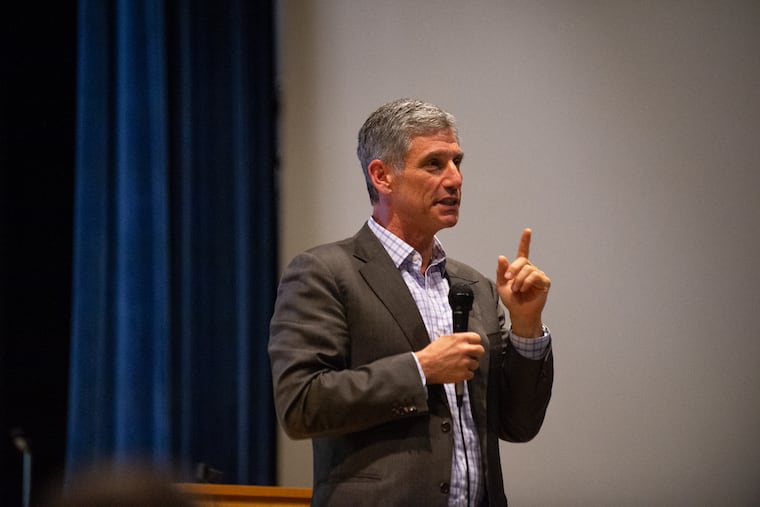With finances growing tighter, state universities told to cut back on adjuncts, combine underenrolled programs
The directive follows a meeting with the 14 university presidents this week where they examined the financial plans for the schools and collectively decided action was needed.

As finances grow tighter at Pennsylvania’s 14 state universities, state system Chancellor Daniel Greenstein has told the schools to curtail the use of adjuncts, combine under-enrolled academic programs, and work more closely to reduce expenses across the 96,000-student system.
The directive follows a meeting with the university presidents this week where they examined financial plans for the schools and decided action was needed, Greenstein said Thursday.
The universities have spent $127 million of their unrestricted reserves — essentially their savings accounts — to balance their budgets and complete projects since 2015-16. Too many of the universities have been drawing on the reserves, which now total $724 million, to balance their budgets, Greenstein said. That’s not sustainable, he said, and is a red flag for accreditors, who review the State System of Higher Education’s financial viability.
A redesign of the system is underway. But, Greenstein said, “We’re not going fast enough, far enough.”
The system has been bleeding enrollment, which has dropped about 20% since 2010, and projections call for the number of high school graduates to take an even steeper decline in coming years.
The universities include Bloomsburg, California, Cheyney, Clarion, East Stroudsburg, Edinboro, Indiana, Kutztown, Lock Haven, Mansfield, Millersville, Shippensburg, Slippery Rock, and West Chester.
» READ MORE: Enrollment falls again across Pennsylvania's state universities
In an email to campus leaders Thursday, Greenstein outlined five steps for the universities to take to improve their revenue picture:
— Curtail the use of adjuncts and temporary faculty. Use full-time faculty more and share them across institutions. If one school needs a course in physics but doesn’t have an available professor, instead of hiring an adjunct, send students in person or online to a campus that has one. Twenty-seven percent of the system’s faculty currently are adjuncts, he said.
— Consolidate under-enrolled programs within a university or across universities. Some programs aren’t attracting enough students to sustain themselves.
— Eliminate vacant positions unless the president deems them necessary. The system also will look at sharing more positions across universities to reduce costs, Greenstein said.
— Improve the retention of students. The system loses nearly a quarter of its students after their freshmen year, which hurts not only the students but also university budgets, Greenstein said. White students are retained at a higher rate than minority students, system data show.
— Move toward a systemwide academic plan that avoids duplication and fills needs across the state.
Faculty union leaders have questions about the plan.
“In an email today to faculty, there’s a more positive call to collective action, but the memorandum to presidents is more authoritarian,” said Jamie Martin, vice president of the Association of Pennsylvania State College and University Faculties. “We’re concerned about how faculty will interpret this — and we’re still interpreting and processing this ourselves as APSCUF leadership.”
The announcement follows the release of Gov. Tom Wolf’s proposed budget this month that would give the system less funding than it requested. The system sought $20 million for its redesign; Wolf proposed nearly $13 million. It also asked for a 2% boost — nearly $10 million — in its yearly appropriation; Wolf proposed flat funding.
The governor, however, also proposed a new scholarship program that could help the system attract more students if it gets legislative approval. The $204 million tuition assistance program could enable about 25,000 students who attend system schools to graduate debt free. The money would come from the state Race Horse Development Trust Fund, and that has horse owners and farmers complaining.
» READ MORE: Gov. Tom Wolf calls for $204 million in tuition assistance for students at Pa. colleges
Greenstein didn’t have projections on how much the steps could save. It will depend on how fully schools embrace the plan and participate, he said. The goal is for the universities to balance their budgets without drawing from reserves without hurting the student experience, he said.
The steps, he said, are meant to encourage greater collaboration across the universities. It’s something that Greenstein has been calling for almost since he became chancellor in 2018.
Not every school is struggling. West Chester, the largest in the system with nearly 17,700 students, has continued to grow. Cheyney, which mounted a successful fight last year to retain its accreditation after years of falling enrollment, also had an enrollment increase this year.
» READ MORE: New chancellor: Pa.’s 14 state universities should start operating more like a system
“There’s a lot we can do, but there’s a lot more we can do if we work together,” Greenstein said. “We are committed to ensuring that we’re able to offer high quality education to all Pennsylvanians. This is about taking very proactive steps in order to make sure we can do that.”